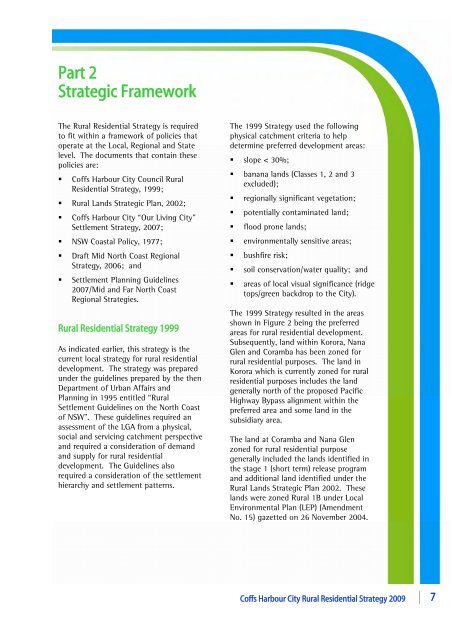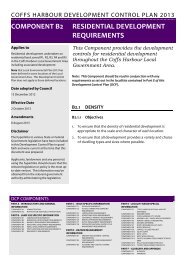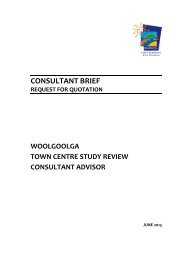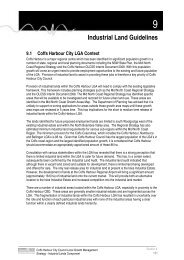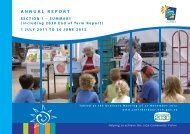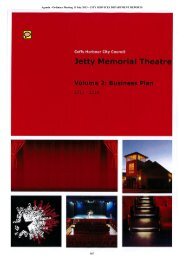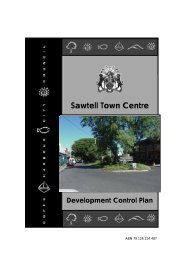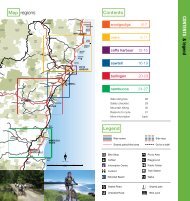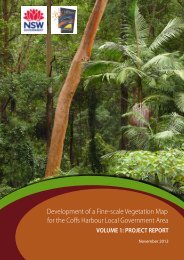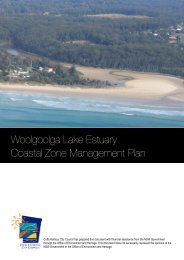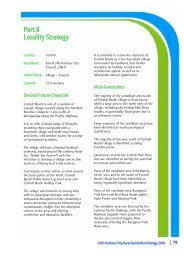Rural Residential Strategy Part 2 - Strategic Framework (.pdf)
Rural Residential Strategy Part 2 - Strategic Framework (.pdf)
Rural Residential Strategy Part 2 - Strategic Framework (.pdf)
Create successful ePaper yourself
Turn your PDF publications into a flip-book with our unique Google optimized e-Paper software.
<strong>Part</strong> 2<br />
<strong>Strategic</strong> <strong>Framework</strong><br />
The <strong>Rural</strong> <strong>Residential</strong> <strong>Strategy</strong> is required<br />
to fit within a framework of policies that<br />
operate at the Local, Regional and State<br />
level. The documents that contain these<br />
policies are:<br />
• Coffs Harbour City Council <strong>Rural</strong><br />
<strong>Residential</strong> <strong>Strategy</strong>, 1999;<br />
• <strong>Rural</strong> Lands <strong>Strategic</strong> Plan, 2002;<br />
• Coffs Harbour City “Our Living City”<br />
Settlement <strong>Strategy</strong>, 2007;<br />
• NSW Coastal Policy, 1977;<br />
• Draft Mid North Coast Regional<br />
<strong>Strategy</strong>, 2006; and<br />
• Settlement Planning Guidelines<br />
2007/Mid and Far North Coast<br />
Regional Strategies.<br />
<strong>Rural</strong> <strong>Residential</strong> <strong>Strategy</strong> 1999<br />
As indicated earlier, this strategy is the<br />
current local strategy for rural residential<br />
development. The strategy was prepared<br />
under the guidelines prepared by the then<br />
Department of Urban Affairs and<br />
Planning in 1995 entitled “<strong>Rural</strong><br />
Settlement Guidelines on the North Coast<br />
of NSW”. These guidelines required an<br />
assessment of the LGA from a physical,<br />
social and servicing catchment perspective<br />
and required a consideration of demand<br />
and supply for rural residential<br />
development. The Guidelines also<br />
required a consideration of the settlement<br />
hierarchy and settlement patterns.<br />
The 1999 <strong>Strategy</strong> used the following<br />
physical catchment criteria to help<br />
determine preferred development areas:<br />
• slope < 30%;<br />
• banana lands (Classes 1, 2 and 3<br />
excluded);<br />
• regionally significant vegetation;<br />
• potentially contaminated land;<br />
• flood prone lands;<br />
• environmentally sensitive areas;<br />
• bushfire risk;<br />
• soil conservation/water quality; and<br />
• areas of local visual significance (ridge<br />
tops/green backdrop to the City).<br />
The 1999 <strong>Strategy</strong> resulted in the areas<br />
shown in Figure 2 being the preferred<br />
areas for rural residential development.<br />
Subsequently, land within Korora, Nana<br />
Glen and Coramba has been zoned for<br />
rural residential purposes. The land in<br />
Korora which is currently zoned for rural<br />
residential purposes includes the land<br />
generally north of the proposed Pacific<br />
Highway Bypass alignment within the<br />
preferred area and some land in the<br />
subsidiary area.<br />
The land at Coramba and Nana Glen<br />
zoned for rural residential purpose<br />
generally included the lands identified in<br />
the stage 1 (short term) release program<br />
and additional land identified under the<br />
<strong>Rural</strong> Lands <strong>Strategic</strong> Plan 2002. These<br />
lands were zoned <strong>Rural</strong> 1B under Local<br />
Environmental Plan (LEP) (Amendment<br />
No. 15) gazetted on 26 November 2004.<br />
Coffs Harbour City <strong>Rural</strong> <strong>Residential</strong> <strong>Strategy</strong> 2009 7
It is to be noted that some of the Stage 2<br />
(medium term) release area in Nana Glen<br />
was also zoned <strong>Rural</strong> 1B under this LEP<br />
Amendment. The southernmost<br />
candidate area in Coramba and<br />
northernmost candidate area in Nana<br />
Glen Rail identified for short term release<br />
were not zoned under this LEP<br />
amendment because of environmental<br />
constraints identified under the <strong>Rural</strong><br />
Lands <strong>Strategic</strong> Plan process.<br />
The Korora <strong>Rural</strong> <strong>Residential</strong> Release Area<br />
included a ‘preferred area’ and a<br />
‘subsidiary area’. Land in the preferred<br />
area not affected by the Pacific Highway<br />
Bypass or identified for higher density<br />
urban development was zoned <strong>Rural</strong> 1B<br />
under LEP (Amendment No. 3), gazetted<br />
in February 2004 and some areas in the<br />
steeper subsidiary areas were subsequently<br />
zoned <strong>Rural</strong> 1B following satisfactory<br />
environmental investigations (i.e. flora<br />
and fauna, geotechnical, bushfire hazard,<br />
effluent disposal). Landowners in the<br />
subsidiary area were able to put forward a<br />
case for rezoning following the carrying<br />
out of certain environmental<br />
investigations.<br />
It is to be noted that the ‘Infill<br />
Development’ areas at Boambee and ‘Tiki<br />
Road’ were also identified for short term<br />
release. Boambee (in the vicinity of<br />
Lindsays Road) was rezoned for rural<br />
residential purposes under LEP<br />
(Amendment No. 17). Rezoning of the<br />
Tiki Road area has been delayed by the<br />
Pacific Highway Upgrade Project,<br />
limitations on the land owing to flooding<br />
and an absence of resources to undertake<br />
the necessary studies.<br />
<strong>Rural</strong> Lands <strong>Strategic</strong> Plan 2002<br />
The <strong>Rural</strong> Lands <strong>Strategic</strong> Plan provided a<br />
strategic direction for all land zoned for<br />
rural purposes in the LGA. The Plan<br />
applied to land zoned <strong>Rural</strong> 1A and land<br />
zoned or intended to be zoned <strong>Rural</strong> 1B.<br />
The <strong>Strategic</strong> Plan sought to achieve a<br />
triple bottom line of economic, social and<br />
environmental sustainability. The<br />
<strong>Strategic</strong> Plan incorporated changes to<br />
Coffs Harbour City LEP 2000 for the<br />
rezoning of the rural residential areas in<br />
Nana Glen and Coramba discussed earlier<br />
and introduced a number of ‘Place’ based<br />
Development Control Plans (DCPs) to<br />
guide rural and rural residential<br />
development. The place based plans<br />
related to:<br />
• Korora and Coastal Hinterland;<br />
• Coffs <strong>Rural</strong>;<br />
• Karangi – Upper Orara – Coramba;<br />
• Nana Glen – Bucca;<br />
• Lowanna – Ulong;<br />
• Northern Beaches.<br />
The <strong>Rural</strong> Lands <strong>Strategic</strong> Plan also<br />
included a Monitoring and Performance<br />
Audit and a Financial Program to ensure<br />
the plan was implemented and the triple<br />
bottom line objectives are met.<br />
Figure 2 shows the areas identified as<br />
candidate under the 1999 <strong>Strategy</strong>.<br />
8 Coffs Harbour City <strong>Rural</strong> <strong>Residential</strong> <strong>Strategy</strong> 2009
Our Living City Settlement <strong>Strategy</strong><br />
2008<br />
The Our Living City (OLC) Settlement<br />
<strong>Strategy</strong> has been prepared to guide<br />
urban development in the LGA for the<br />
next 23 years. The OLC Settlement<br />
<strong>Strategy</strong> was prepared to meet the<br />
obligations for urban release strategies<br />
under the North Coast Regional<br />
Environmental Plan. The OLC Settlement<br />
<strong>Strategy</strong> details areas to be zoned or<br />
investigated for urban and rural<br />
residential purposes.<br />
The <strong>Strategy</strong> envisages a population of<br />
approximately 99,000 people by 2031<br />
requiring an additional 12,000 dwellings.<br />
<strong>Rural</strong> residential dwellings are anticipated<br />
to comprise 5.33% (i.e. 640 dwellings) of<br />
this future dwelling stock.<br />
The candidate areas for rural residential<br />
development to be considered under this<br />
<strong>Strategy</strong> are shown in Figure 3.<br />
The Department of Planning has endorsed<br />
an interim agreement to allow some areas<br />
identified in the <strong>Strategy</strong> to be considered<br />
for rezoning for urban purposes in the<br />
short term. These areas include:<br />
• North Coffs Release Area;<br />
• South Coffs Release Area;<br />
• Two land parcels in Bonville;<br />
• Two land parcels subject to zoning<br />
anomalies; and<br />
• Three parcels of land for special<br />
investigation.<br />
The Department of Planning intends to<br />
consider the remaining contents of the<br />
OLC Settlement <strong>Strategy</strong> when the Mid<br />
North Coast Regional <strong>Strategy</strong> is<br />
completed. It is expected that the OLC<br />
Settlement <strong>Strategy</strong> will be amended to<br />
incorporate the findings and<br />
recommendations from this <strong>Strategy</strong>.<br />
Mid North Coast Regional <strong>Strategy</strong><br />
This <strong>Strategy</strong> was endorsed in 2009 and<br />
applies to eight local government areas<br />
including:<br />
• Coffs Harbour;<br />
• Nambucca;<br />
• Clarence Valley;<br />
• Bellingen;<br />
• Kempsey;<br />
• Port Macquarie-Hastings;<br />
• Greater Taree; and<br />
• Great Lakes.<br />
The <strong>Strategy</strong> states that its primary<br />
purpose is to ensure adequate land is<br />
available and appropriately located for the<br />
housing and employment needs for the<br />
region to the year 2031. The <strong>Strategy</strong><br />
projects 91,000 additional people, 58,400<br />
new homes and the provision of 47,000<br />
new employment opportunities in the<br />
Region. For the Coffs Coast, which<br />
includes Nambucca, Bellingen and Coffs<br />
Harbour, 18,600 dwellings are projected.<br />
As can be seen by the dwelling<br />
projections under the OLC Settlement<br />
<strong>Strategy</strong>, the majority of this new housing<br />
will be located in the Coffs Harbour LGA.<br />
This is confirmed in the Regional <strong>Strategy</strong><br />
wherein it states:<br />
Coffs Harbour, Moonee Beach,<br />
Woolgoolga and Sawtell-Toormina-<br />
Boambee East have the greatest<br />
potential to accommodate the growth<br />
expected in the coastal areas of this<br />
sub region.<br />
Coffs Harbour City <strong>Rural</strong> <strong>Residential</strong> <strong>Strategy</strong> 2009 9
The following centres hierarchy is<br />
outlined in the <strong>Strategy</strong>:<br />
• Coffs Harbour – Major Regional<br />
Centre;<br />
• Woolgoolga – Town;<br />
• Red Rock – Coastal Village;<br />
• Corindi Beach – Coastal Village;<br />
• Mullaway – Coastal Village;<br />
• Sandy Beach – Coastal Village;<br />
• Emerald Beach – Coastal Village;<br />
• Moonee Beach – Coastal Village;<br />
• Nana Glen – Inland Village;<br />
• Coramba – Inland Village;<br />
• Ulong – Inland Village; and<br />
• Lowanna – Inland Village.<br />
Coffs Harbour is designated as a ‘Major<br />
Regional Centre’ to serve the Coffs Coast,<br />
Woolgoolga is designated as a supporting<br />
Town Centre and the remaining centres<br />
are designated as villages. It is interesting<br />
to note that the significant centres of<br />
Sawtell, Toormina, Boambee and Bonville<br />
are not separately recognised in the<br />
hierarchy under the <strong>Strategy</strong>.<br />
The <strong>Strategy</strong> requires the amount of<br />
housing in existing urban areas to be<br />
increased from 20% to 40%; this will<br />
require a dramatic shift to more rigorous<br />
urban consolidation policies and<br />
provisions at the local level. In relation to<br />
rural residential development the <strong>Strategy</strong><br />
states:<br />
• No further rural residential areas will<br />
be supported beyond those identified<br />
in the Regional <strong>Strategy</strong> unless the<br />
local growth management strategy<br />
can demonstrate that the proposed<br />
areas:<br />
> are consistent with the<br />
Sustainability Criteria.<br />
> maintain the character and role of<br />
the existing village centre.<br />
• Future rural residential land will only<br />
be zoned for release if it is in<br />
accordance with a local growth<br />
management strategy agreed to<br />
between council and the Department<br />
of Planning and consistent with the<br />
principles of the Settlement Planning<br />
Guidelines.<br />
• <strong>Rural</strong> residential development will be<br />
permitted in coastal areas only if<br />
already zoned or within an agreed<br />
growth management strategy.<br />
• Planning for rural residential land<br />
must be integrated with the supply of<br />
infrastructure and transport.<br />
• The Department of Primary Industries<br />
and the Department of Planning will<br />
assist councils with the development<br />
of appropriate subdivision standards<br />
for rural zones.<br />
• Local environmental plans will include<br />
minimum subdivision standards for<br />
rural and environment protection<br />
zones.<br />
10 Coffs Harbour City <strong>Rural</strong> <strong>Residential</strong> <strong>Strategy</strong> 2009
• Local environmental plans will include<br />
provisions to limit dwellings in rural<br />
and environmental zones.<br />
• Local environmental plans will not<br />
include provisions to permit<br />
concessional allotments.<br />
It is necessary for this <strong>Strategy</strong> to<br />
demonstrate compliance with the<br />
sustainability criteria outlined in the<br />
<strong>Strategy</strong>. This criteria relates to:<br />
• infrastructure provision;<br />
• access;<br />
• housing diversity;<br />
• employment lands;<br />
• avoidance of risk;<br />
• natural resources;<br />
• environmental protection; and<br />
• quality and equity in services.<br />
Appendix A describes the criterion and<br />
measures to meet each criterion in this<br />
<strong>Strategy</strong>.<br />
NSW Coastal Policy 1997<br />
The NSW Coastal Policy was developed to<br />
guide management and planning of the<br />
coastal zone into the next century. The<br />
coastal zone includes the following areas:<br />
• three nautical miles seaward of the<br />
mainland and offshore islands;<br />
• one kilometre landward of the open<br />
coast high water mark;<br />
• a distance of one kilometre around:<br />
> all bays, estuaries, coastal lakes,<br />
lagoons and islands;<br />
> tidal waters of coastal rivers to<br />
the limit of mangroves, as defined<br />
by NSW Fisheries’ (1985) Figures<br />
or the tidal limit whichever is<br />
closer to the sea;<br />
with the line on the Maps being taken<br />
to the nearest cadastral boundary<br />
and/or easily recognisable physical<br />
boundary, in consultation with local<br />
councils.<br />
Figure 1 shows the coastal zone boundary<br />
within the Coffs Harbour City LGA.<br />
The Coastal Policy establishes a number<br />
of broad objectives and “<strong>Strategic</strong><br />
Actions” that apply to the preparation of<br />
LEPs. These actions and the means by<br />
which this <strong>Strategy</strong> will address each<br />
strategic action are outlined in<br />
Appendix B.<br />
Coffs Harbour City <strong>Rural</strong> <strong>Residential</strong> <strong>Strategy</strong> 2009 11
Settlement Planning Guidelines –<br />
Mid and Far North Coast Regional<br />
Strategies 2007<br />
This document supplements the Mid<br />
North Coast Regional <strong>Strategy</strong> by<br />
outlining guidelines for local growth<br />
management strategies required under the<br />
Regional <strong>Strategy</strong>; the OLC Settlement<br />
<strong>Strategy</strong> is the equivalent of a local<br />
growth management strategy.<br />
The Guidelines provide details on the<br />
environmental criteria to be used,<br />
planning and urban design principles and<br />
a housing and land monitor framework<br />
for urban, as well as rural residential,<br />
development. These Guidelines allow<br />
current local settlement strategies to be<br />
used as “interim local growth<br />
management strategies” if the strategy is<br />
consistent with the guidelines and<br />
regional strategies; the status of the<br />
interim OLC Settlement <strong>Strategy</strong> is derived<br />
from the Guidelines.<br />
The scope and content required by the<br />
guidelines and how this strategy meets<br />
these requirements are detailed in Table 1.<br />
Table 1<br />
Settlement Guidelines<br />
Scope and Content - Requirements and<br />
Response<br />
Requirements<br />
Strategies to include<br />
a vision which<br />
considers regional<br />
context and role of<br />
LGA in this region<br />
Comply with<br />
Sustainable<br />
Settlement Guidelines<br />
Detail community<br />
consultation<br />
Information on<br />
constraints mapping<br />
to be included<br />
Information on<br />
desired local<br />
character and form<br />
Services and<br />
Infrastructure<br />
Land supply and<br />
demand<br />
Land Release program<br />
including location,<br />
yields and timing<br />
Servicing and<br />
infrastructure<br />
program<br />
Review period<br />
Response<br />
The vision and<br />
objectives detailed<br />
earlier for the strategy<br />
satisfy this<br />
requirement.<br />
Appendix A details<br />
the sustainability<br />
criteria and how it is<br />
met.<br />
<strong>Part</strong> 6 and Appendix<br />
C detail the<br />
community<br />
engagement process.<br />
<strong>Part</strong> 5 details the<br />
constraints mapping<br />
used.<br />
The locality strategies<br />
detail the desired<br />
local character and<br />
form; see <strong>Part</strong> 8.<br />
<strong>Part</strong> 6 outlines the<br />
services and<br />
infrastructure issues<br />
addressed.<br />
The balance sheet in<br />
<strong>Part</strong> 3 describes the<br />
supply and demand<br />
for rural residential<br />
housing and lots.<br />
The land release<br />
program is included<br />
under the<br />
Recommendations<br />
after <strong>Part</strong> 8.<br />
The services and<br />
facilities will fall<br />
within existing<br />
programs<br />
Review every five<br />
years<br />
12 Coffs Harbour City <strong>Rural</strong> <strong>Residential</strong> <strong>Strategy</strong> 2009
Snapshots<br />
The candidate areas for rural residential development considered under this <strong>Strategy</strong><br />
included Korora; Moonee; Bonville; Karangi; Coramba; Nana Glen; Corindi and Red Rock.<br />
The <strong>Rural</strong> <strong>Residential</strong> <strong>Strategy</strong> is required to fit within a rigid framework of policies that<br />
operate at the Local, Regional and State level; these policies require consideration of<br />
sustainability criteria and generally encourage compact towns and cities.<br />
<strong>Rural</strong> residential land can only be released if it is in accordance with a strategy agreed to<br />
between council and the Department of Planning and consistent with the prescribed<br />
sustainability principles of the Settlement Planning Guidelines.<br />
Planning for rural residential land is required to demonstrate that the proposed areas can<br />
maintain the character and role of the existing villages and must be integrated with the<br />
supply of infrastructure and transport.<br />
The <strong>Strategy</strong> will ultimately lead to the preparation of local environmental plans for the<br />
rezoning of selected candidate areas, these local environmental plans are required to<br />
include minimum subdivision standards and are not to permit concessional allotments.<br />
Coffs Harbour City <strong>Rural</strong> <strong>Residential</strong> <strong>Strategy</strong> 2009 13
14 Coffs Harbour City <strong>Rural</strong> <strong>Residential</strong> <strong>Strategy</strong> 2009


